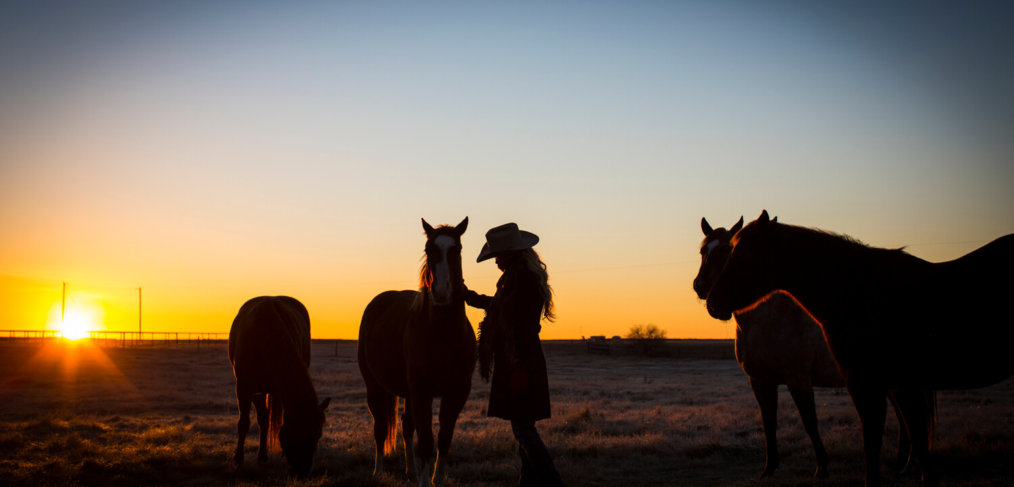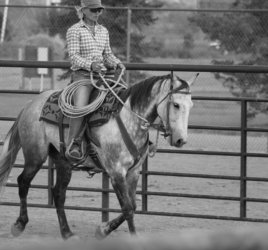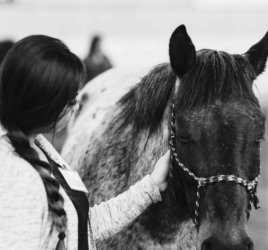
Finding Solitude in the Arena
We’ve all heard the statement “if you want something done ask a busy person.”
If you want it done really well ask Ingrid. She is what you might say, one busy woman. In the past two decades Ingrid raised three kids, bought an ailing horse publication and turned it around and has been involved with a variety of community activities. Nowadays she serves on the board of the Alberta and Canadian Cutting Horse Associations as well as Stampede Western Performance Committee.
Then just when some people are thinking of slowing down, Ingrid and her partner Dean Ness embarked on a new adventure, opening Cody & Souix in Inglewood, Calgary. The store offers a blend of modern west clothing and a curated selection of artists and artisan work. For Ingrid it is much more than a store, Cody & Souix represents a lifestyle that speaks to frontier ideals such as individualism, a life outdoors and protecting the remaining wide open spaces of the West.
Ingrid also rides cutting horses.

—————-
Ingrid interviewed me about my business The Natural Leader for Western Horse Review, so it was fun to sit on the other side of the table. This is our conversation.
———
How have horses influenced your leadership style or your communication style
I.S. – hmm – horses really are a balance for me. Particularly through competition. I really debated getting into the sport. I was already a busy person. I had a business, household to run, the kids were young and I’m usually taking a course and involved with a variety of boards. When I told some friends, I was thinking of getting into cutting, they looked at me and said “Are you nuts? You’ve got so much going on already.”
But what I found it was time in the saddle balanced me, settled me as a person, a boss and as a mom.
This is how much I loved that weekly lesson. One stormy December, they hadn’t yet closed the highways but driving was bad. It was more than an hour to get to my lesson with Cub Wright on good roads, but it hadn’t even occurred to me that we wouldn’t have our lesson. When I arrived in the midst of the snowstorm the barn was dark so I went up to the house. Cub was totally amazed to see me as she had assumed I wouldn’t come. That was how much I needed that lesson. How much I needed that balance.
———
How did you get into the magazine business?
I.S. – I had applied to work with a large family owned publication and printing company. The brothers who owned it were from Saskatchewan, as was I, so almost immediately we hit it off. I don’t know where I got the courage from but in the initial interview, I said I wanted to change their whole production system from typesetting to digital. I would work for a month for free. I was doing all that on my MacSE with 2 MGs of ram.
A week later they put me on payroll, said they weren’t going to make me work for free, and I ended up running the whole production department. The technology left a few really good people displaced and I remember at the time how tough that felt, conflicting really.
When the firm split up I went with the brothers to their new company, they remain great friends and mentors. I guess that is when I got the publishing bug. I ended up buying The Northern Horse Review (now WesternHorseReview) at the brink of it shutting down, that was 1997.
At the time my sister was the National Sales Manager with the Calgary Herald and helped me set up the sales side of the business and a month later she joined me. She left a secure job to nurture this publication with me – we worked together for almost 20 years and built it into a sweet gig for both of us.
Through the magazine I returned to my rural routes and it rekindled my interest in horses. I hadn’t been around them much since I was a child, but the first cutting horse competition I went to, I was completely smitten.
———
To your first comment about balance. You were also involved with 4H with your daughters – that’s a program that offers a great balance for kids.
I.S. – Totally! Also support and teamwork I really believe 4H was a rich experience. Both of my daughters were in 4H and it taught them, and myself as a leader of the club so much. It’s a program that includes public speaking, volunteering and horses for youth.
I was a single mom in a very traditional community and living on the acreage alone. I was really fortunate for the support group that grew around me. My girls saw a range of kids in that program from very well off, to those just above the poverty line – so they learned how important the support of community can be.
———

Photo Credit: Krista Kay
If there was one thing horses have taught you, you wish you could share with others.
What would that be?
IS – Quietness.
In a cut, once you have your cow separated from the herd, the rules require the rider to lay her hand down on the neck of the horse. You have to trust the horse to do its job.
There is a need for quietness on the part of the rider. It’s a really interesting, and often freaky, situation to navigate. There you are in the vortex of explosive and often chaotic action and what is required, is not reaction or reactiveness, though slivers of both inevitably gush through. Trust me, there is nothing like a cutting horse to teach you how delusional you are about your riding ability.
Above all, there is a need for quietness.
That horse has to read the cow and to be quicker than it. While the rider can help the horse with leg aids and weight shifts, it is critical to be quiet and stay out of the horse’s way.
It boils down to what Buster Welch said: “if you are thinking about your riding, you are interfering with your horse.” I think its something I am learning with many hours in the saddle, and has a lot to do with what horse people refer to as “feel”, something I continue to work on!
Imagine all of the day-to-day scenarios if you armed yourself with quietness – you could rock a situation, instead of drowning in it. Confrontations with co-workers. Challenges with kids. A fight with a spouse. Near car accidents.
Sure, there was a day when I would throw a dish, or a book, across a room, and storm out a door. While, I wouldn’t say I’ve evolved entirely above that sort of reactiveness, my brain has made the connection between quietness in the saddle and quietness in “real life.”
I’m much better and braver with people than I have ever been.
The other quietness is more about solitude. I need that to initiate creative thought.
A horse is so incredibly laid-back and quiet in its element in the paddock, just swatting flies and blinking eyes, nuzzling and scratching. It’s enlightening, just observing that behavior. I’ve fleshed out more than one story idea during a brushing session in the pasture. Just hanging out with these incredible creatures so in harmony with the concepts of rest, quietly recharging.
So it’s the importance of quietness. That’s what cutting horses, horses in general have taught me.
———
Thank you Ingrid – I can’t think of a better way to end an interview.
Photo Credits: Krista Kay Photography



